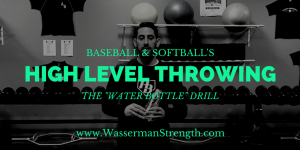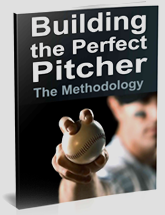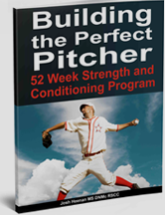Move Fast, Throw Hard, Live Well – Early Off-Season
With the fall upon us and our baseball guys entering their off-season, we get an increase in volume of athletes looking to overhaul their fitness and performance training. The follow articles offer good info for the early off-season.
A Peek Into The Sleep Habits Of Teenagers Around The World – Sleep length and quality is not only important for recovery from training and sport, but is immense for long-term health. Sleep is one of the most abused recovery tool we have available for each and every athlete.
High Level Throwing – I had the pleasure of meeting Austin this past winter. Austin does a great job at breaking down high level throwing mechanics. This is the perfect time of year to implement Austin’s tools to fix your mechanics.
Why Your Conditioning is Hurting Your Performance on the Mound – This throwback article gives some insight to how we condition pitcher and prepare our position players to have a powerful first step.
Interview With Josh Heenan
(Written by Michael Wittner)
For more than seven years, Josh Heenan has worked in the field of sports training and medicine. He has a doctorate in Integrated Medicine and is currently Head Strength Coach and Doctor of Integrated Medicine at Moore Fitness and Physical Therapy in Southport, Connecticut. Prior to working at Moore, he was the Head Strength and Conditioning Coach for Sacred Heart University’s Baseball Program, a Division 1 baseball school. In addition, Josh has a master’s degree in Human Movement and Sports Psychology and bachelor’s in Exercise Science.
Josh currently trains athletes at numerous levels starting from high school and continuing through the professional level. He also has been a consultant to multiple organizations for sports training and rehabilitation. In an exclusive interview, Josh described his influences and philosophies in training, medicine, and rehabilitation.
Mike: What made you interested in the field of strength and conditioning, physical therapy, and medicine?
Josh: From when I was very little I always remember my father exercising. He was in the sports medicine field during his early 20′s working with the Celtics and Patriots. From there he became a police officer and always said his job was a “full-contact sport” and prepared for the worst so he would always come home in one piece. When I was about 14 I fell in love with the process of training and how the hard work allowed me to stay ahead of my competition.
M: Were you considering other majors at the time or were you only interested in strength and conditioning, physical therapy, and medicine?
J: If I did not have option to play baseball in college, I would have likely tried to become a Navy SEAL. I love the mental side of training (which they have come close to mastering) and pushing my body to the limits was enticing—not to mention being our first line of defense for the USA.
M: After entering the field, how has it made an impact on your life?
J: Many people say they love their jobs, but I doubt many love it as much as I do. I have the best clients in the world. I wake up everyday excited to help motivated people (athletes and non-athletes) pursue their goals. I was never a reader growing up (this was evident in probably the worst SAT English/Math split in the history of the exam), but once I entered college I literally read anything I could get my hands on in the field. To this day, I read research whenever I have a free minute and go to bed reading research. We have come so far in the fields of performance enhancement, therapy, and medicine—yet we are still barely scratching the surface.
M: What is your philosophy on physical training and how is it different from other trainers?
J: Everyone moves differently due to posture, orthopedics, injuries, and other limitations; not to mention each has a different health history and short/long term goals. Posture dictates function. In turn, each person should be treated as an individual and look for relative improvements.

M: In your experience, what are the most limiting and most common problems that your athletes have?
J: Most young athletes don’t move very well and are incredibly weak. Everyone wants the magic formula to run fast, throw hard, and move well. It’s really simple, learn to move well and get as strong as possible in movements that relate to your ultimate goal(s). Strength is corrective and will allow you to express your potential for speed and health.
M: How do these problems affect the athlete’s performance in training and playing their sport?
J: Strength and movement limitations are the reasons we get injured (except for contact injuries). My number one goal as a coach/therapist is to keep our athletes healthy and on the field.
M: Is there a certain way that one should train during the season vs. the off-season?
J: These are generalities, but in-season we tend to use less total volume of work with a bit higher intensity and off-season we use more volume of work.
M: Which is more important strength or agility, or are both needed in order to keep each other balanced? Why?
J: Strength is the foundation for speed and agility. With greater strength, we have a higher ability to express force output through agility, power, and speed. Strength elevates all athletic qualities.
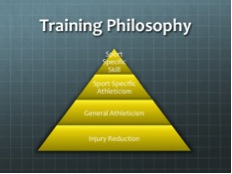
M: Lastly, how would you define eating properly? Is it different for every person? Why?
J: Eating “properly” is determined by someone’s goals. If you want to be the next Kobayashi, then eating 50 hot dogs a day may not be the worst thing for your goals. Everyone defines healthy and fit in a different way– you would have to define it before I can advise on how to best attain those goals.

M: Thank you very much for your time. It was a very informative interview.
J: It was my pleasure!
Hip Arthroscopic and Incidences of Total Hip Replacement
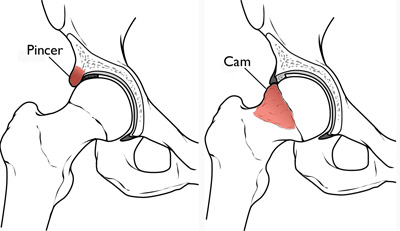
Earlier today I had a video consult with a 28 year old powerlifter with femoroacetabular impingement copmaining of hip pain while squatting, and atrophy of the glute medius region. This athlete had consulted with numerous surgeons and rehab specialists trying to figure out how to address his impingement with and without surgery. As the athlete noted, some surgeons he spoke with had a good grasp of what his options were and possible outcomes, while some had no idea and offered completely outdated information.
I sent him the following literature to highlight some of the more current research on possibly dodging a total hip replacement. As stated, there are no guarantees and every case is different, but some of the facts are very much in his favor.
“Attached is research on patients whom have an arthritic hip and had arthroscopic surgery. The study tracks incidents of total hip arthroplasty post-arthroscopic debridement. Out of 564 patients in the sample, only 16% (90 patients) eventually required THA over the 7-year period. The mean age for the subjects was 55 years old.
To me, this gives high hopes for a younger athlete like yourself whom wants to avoid having total hip replacement and wishes to compete at a high level. I think the most enlightening information from this study was “75% of the patients with severe OA did not require THA by the end of the study.”1
Obviously there are lots of variables for each patient, but with a great surgeon and rehab specialist you should mitigate a ton of your long term risks.”
The incidence of total hip arthroplasty after hip arthroscopy in osteoarthritic patients
1. Haviv B, O’Donnell J. The incidence of total hip arthroplasty after hip arthroscopy in osteoarthritic patients. Sports Med Arthrosc Rehabil Ther Technol SMARTT. 2010;2:18. doi:10.1186/1758-2555-2-18.
Quinnipiac Men’s Hockey and In-Season Training

As the collegiate hockey season ends, I am sure many local Connecticut hockey players have taken special notice of Quinnipiac’s hockey present on the national level. Unfortunately, they fell just short of the national championship; nonetheless, they should be a contender in the coming years on the same stage.
For those who have had a chance to see the changes QU has made to their hockey facilities over the past ten years, its obvious that the school wanted to develop a national level program from the ground up. What many do not get to see is the countless hours of off the ice training that this team has put in.
Since 2008, Brijesh Patel has run the strength and conditioning for both men/women’s basketball and hockey programs. B is not only preparing his athletes for their current endeavors, but also building them to excel at the highest level of sport.
One aspect of training that seems misunderstood by many sport coaches is in-season training. Here B highlights some of his in season with his men’s hockey team. Coaches often look for their athletes to bust their butt in the off-season to build foundational strength and be ready for the on-field/ice rigors, but maintaining those power/strength/flexibility/mobility qualities takes hard work in-season.
My first goal as a strength and conditioning coach is to have my athletes healthy and be able to take the field. My second goal is to increase performance on the field. This means understanding how each training session plays a role in that week, month, and years cycle of development for each player. Yes, training can leave you tired, sore, and mentally drained, but a good strength coach will know how to adjust variables to not leave them feeling or preforming poorly. This is evident with a 2-month block where QU hockey didn’t lose a game.
Here at Moore in Southport, we aim for our athletes train in-season 1-3 times a week depending on their practice and game schedule. Saturday we had 70% of our baseball clientele in training from youth, high school, to pro. Each athlete has their own in-season program that is geared to keep them powerful, strong, and healthy. Many of our athletes set personal records while their in-season due to hitting growth spurts and having just the right amount of stimulus to perform at their best.
Optimizing Recovery From Injury
Recovering from an injury or surgery has numerous variables that the injured person can manipulate to promote healing and faster recovery.
Many of you reading this likely know that I just underwent a femoroacetabular impingement (FAI) surgery. I am currently writing this post from hospital bed at 3 am to keep my sanity intact while waiting for the nurses to check my vitals every few hours.
When prepping clients for a surgery or athletes recovering from an injury I always try to stress what they can change NOT what is out of their control. Some of these variables include diet, supplementation, sleep, stretching, and strengthening to name a few.
I have attached a link with my go to guide I offer clients to help understanding the injury process and how they can dramatically effect the healing process through nutrition. I encourage anyone who has the slightest interest in optimizing health, recovery, or fitness to read it from front to back.
If you have any questions feel free to comment below.
Myth: Dieting And Hitting The Gym Are The Only Ways To Stay In Shape
Yep, you heard it here first, the sad truth is research has found that exercise does not work in changing body composition and diets don’t work because of a lack of compliance.
Let’s delve a bit deeper.
The Lost Art of Recovery: Quality Sleep
Recovering from the stresses of working out and life is often the most forgotten part of making progress in the gym and on the field.
Working daily with my college athletes reminds me that quality of sleep is virtually obsolete these days. Whether it comes from staying up late drinking, doing homework, or just hanging with friends, it often leads to under 5 hours of sleep a night… which is about half of the recommended 9.
While my first recommendation in regards to sleep is to find time to take naps throughout the day to make up for lost sleep, but most of these young adults don’t have time for this option either.
 Fortunately for them I am often in the same situation working crazy hours, taking graduate classes, coaching a baseball team, and training myself. To optimize my sleep, I have been using Sleepytime Tea by Celestial Seasonings for the past year. I use it with a teaspoon of honey right before bed to help me unwind from the, and it works amazingly.
Fortunately for them I am often in the same situation working crazy hours, taking graduate classes, coaching a baseball team, and training myself. To optimize my sleep, I have been using Sleepytime Tea by Celestial Seasonings for the past year. I use it with a teaspoon of honey right before bed to help me unwind from the, and it works amazingly.
Last week I was visiting a friend at a local natural foods store he owns and I stumbled across Sleepytime Extra tea. I bought it and used it that night. The only thing I can remember is laying on my bed about to turn on the TV and I was out cold before I could hit the power button. I had probably the deepest sleep of my life and woke up with zero grogginess, even with the added valerian root.
Celestial Seasonings has a wide variety of teas, all of which are all natural, quality products. I highly recommend anyone whom wishes to increase the quality of their sleep to give both of these products a try for added recovery. Let me know how it goes!
Little Adjustments
Although I am young I have been very lucky in my career to only have one serious injury, and that was to my throwing shoulder.
Recently I have been dealing with some hip and lower back pains. Nothing to crazy just more or less nagging at my right side. I looked at my workouts and didn’t see much of a problem. I checked my footwear and found it to be correct for my feet. I moved on to my ankle and hip mobility work and saw that they were in a normal range for myself.
So what gives?
I realized after a thanksgiving induced food coma that I woke up face first, neck cramped, body all over the place in a pillow. This may seem normal to most, but I realized that I had been waking up like this on a regular basis and sleeping on my chest has always lead to general body aches.
So starting that night when I go to sleep I stuff a pillow between my legs to help create a more neutral hip and spine alignment when I sleep. Every day since my pain has been gone.

Don’t search “pillow between legs” on Google images without a filter on, you may be surprised at what shows up.
Now do I think this will cure everything, unfortunately no, but I realized one of the problems I’m dealing and corrected it along with making subtle changes to my training to correct the problems.
With all that being said, small simple adjustments can often have a large impact. I used this technique with a pillow for a friend whom had dealt with lower back pain for years, seeing someone who woke up everyday in pain to waking up in no pain is slightly happier to say the least.
It’s All In Your Head
One of my favorite quotes is “what the mind can conceive and believe, the body can achieve”. Most people agree that the mind is one of the most powerful things in the world and when used to its potential can be a potent weapon in ones arsenal. Don’t believe me read this http://www.nytimes.com/library/magazine/home/20000109mag-talbot7.html
Over the course of this experiment, no one complained about the outcome of their surgery, and believed that the job was done.
If you can have people believe that a false knee surgery was preformed with no such surgical repair, what do you think is possible if you get your mind right in the gym and on the field?

It’s never to early for mental rehersal


